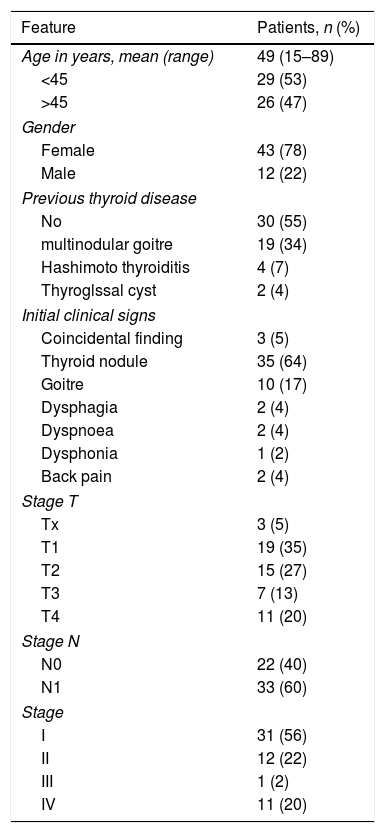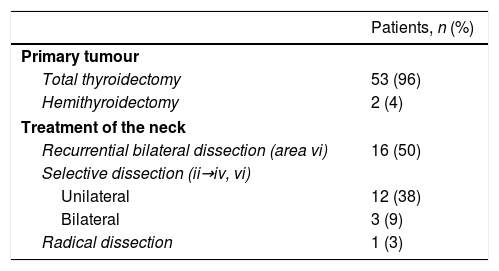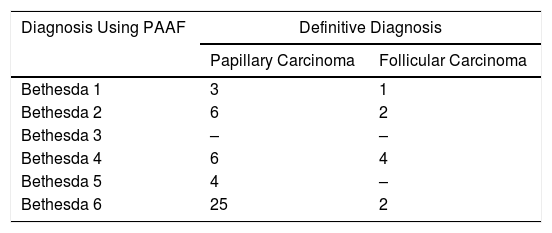Radioiodine is the principal treatment for differentiated thyroid carcinomas. The aim of this study is to present our experience in the management of these tumours.
Material and methodWe present a retrospective study of 55 patients operated for differentiated thyroid carcinoma in our hospital between 2007 and 2011.
ResultsThe mean age at time of diagnosis was 49 years, and females predominated (78% of cases). Seventy eight percent of the patients were in the initial stages (stages I and II). The definitive histopathological diagnosis was papillary carcinoma in 84% and follicular carcinoma in the remaining 16%. All of the patients, with the exception of 2 (4%), underwent total thyroidectomy, with lymphadenectomy in 58% of cases. Nine percent of the patients had permanent hypoparathyroidism and although 18% suffered transitory unilateral paralysis, 40% of these female patients had completely recovered after 6 months. Eighty-nine percent of the patients were given radioiodine postoperatively. There was a recurrence rate of 40% most of which was at cervical level (29% of the patients). Survival at 5 years was 87%, 95% of the papillary subtype, falling to 56% of the follicular subtype (P=.001).
Discussion/conclusionsThe prognosis for differentiated thyroid carcinomas is excellent after appropriate surgical treatment, thorough preoperative assessment, and strict postoperative follow-up due to the significant recurrence rates.
El tratamiento principal de los carcinomas diferenciados de tiroides es la cirugía seguida de radioyodo. El propósito de este estudio es exponer nuestra experiencia en el manejo de estos tumores.
Material y métodoSe presenta un estudio retrospectivo de los 55 pacientes intervenidos quirúrgicamente de un carcinoma diferenciado de tiroides en nuestro hospital entre los años 2007 y 2011.
ResultadosLa edad media al diagnóstico fue de 49 años, con un predominio femenino (78% de los casos). El 78% de los pacientes se encontraban en fases iniciales (estadios I y II). El diagnóstico histopatológico definitivo fue de carcinoma papilar en el 84% y folicular en el 16% restante. A todos, salvo a 2 pacientes (4%), se les realizó una tiroidectomía total, acompañada de linfadenectomía en el 58% de los casos. Un 9% de los pacientes presentó hipoparatiroidismo permanente y aunque un 18% sufrió parálisis recurrencial unilateral transitoria, un 40% de ellos se recuperó completamente a los 6 meses. Se administró radioyodo en el postoperatorio al 89% de los pacientes. Se produjo un 40% de recidivas, la mayor parte de las cuales (29% de los pacientes) se localizaron a nivel cervical. La supervivencia a los 5 años fue del 87%, siendo del 95% en el subtipo papilar y descendiendo al 56% en el folicular (p=0,001).
Discusión/conclusionesLos carcinomas diferenciados de tiroides son tumores con un pronóstico excelente tras un tratamiento quirúrgico adecuado previa valoración preoperatoria exhaustiva y seguimiento postoperatorio estricto debido a las tasas significativas de recidiva.












